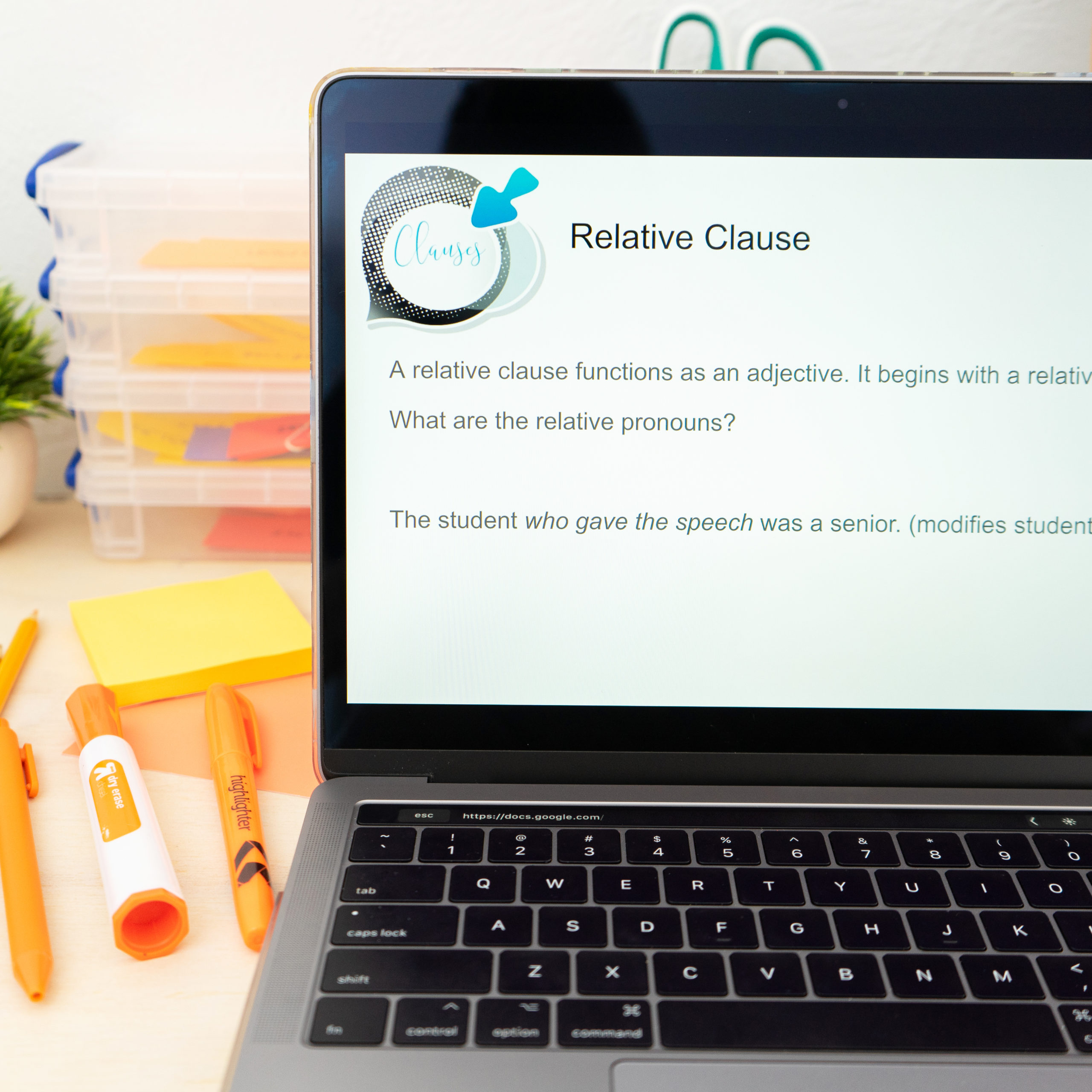Interested in making high school grammar resources meaningful? Discussing grammar and language with high school students can create memorable lessons.
In my post middle school resources, we discuss middle school language standards with an emphasis on grammar. High school grammar resources have some similarities. Let me explain my thoughts on why.

Why high school grammar resources?
For the first years of my teaching career, grammar activities for high schoolers addressed similar content as for middle schoolers. New standards changed this.
In middle school, students learn lots of concepts. Students should own grasp of grammatical terms by the end of eighth grade. If you follow the Common Core, classes in lower grades are to learn about verbals and phrases; in high school, classes are to use phrases to “convey specific meanings.”
But (and this is a huge one), students must actually know the definition of a phrase, be able to identify a phrase, and write a phrase before they can manipulate phrases to “add variety and interest to writing.” Those standards are difficult for some classes.
How can I make learning grammar more interactive and engaging?
Know where your learners came from in middle school, and build activities from there. Give older learners opportunities to explore language. (In my writing, I typically use “grammar” and “language” interchangeably because of the standards.)
Almost all high school students need a review in various ways. (I typically give a grammar diagnostic so that I’m not repeating concepts they already know.) Secondly, the age groups differ in their approach to learning. Even if you teach the concept to middle schoolers, your resources for high schoolers will need a different presentation.
High school students are a tough crowd. They’re almost adults, but they’re not. And freshmen are entirely different from seniors. Actually, each year of high school has varying growth, strengths, and issues.
Plus, high school language standards are difficult. To meet those standards, students need a working vocabulary, domain-specific vocabulary.
When creating any lesson plan, authenticity is key. Especially with high school grammar resources, classes want to know the impact a lesson will have on them. I encourage my classes to question! Teachers should then be prepared to address the connection of real life to lessons.
How can I cover nouns, verbs, punctuation, clauses, vocabulary—all English language standards?
If you look at language standards for high school, you might feel overwhelm, which makes sense. All the younger standards build to high school ones. When older learners do not have a firm grasp of basics like nouns and verbs, you might scaffold review into their current lessons. Below, I’ll cover how to teach basics in non-elementary ways.
Plus, English language standards include vocabulary. This inclusion is a positive! Not only can your grammar instruction cross over to student writing, but you can also connect writing skills and grammar skills to vocabulary. The best way to teach grammar is to connect it to other pieces.
Here are some discussion points I use when discussing grammar with older students. As you work toward meeting language standards with your older classes, incorporate these ideas into your lessons.
Feel free to make these your own as you discuss high school grammar resources.
Connect language to a future career
If I ask students what their future career plans are, I get a variety of responses: lawyer, marketing executive, teacher, engineer, EMT, translators, and other jobs with obvious writing components. All jobs require effective written communication on some level.
Other careers mentioned may have less obvious needs for writing, but do nonetheless. Business specialists, retail managers, and salespeople require some writing but students may not understand that in all jobs, advancement happens from an ability to show initiative and growth. Often this is done with research, with better proposals, with writing. Professionals spend up to two hours of their days writing.
Our current classes must be able to evaluate and correct their writing errors. Part of teaching high school grammar is connecting ideas with students: show them that they will write, and no one will be with them to correct their writing.
Possessing a firm understanding of language will make their writing better and help them succeed in their careers. High school grammar resources should remind students of the connection.
Explain the world outside of a high school ELA class
Discussing grammar with high schoolers. . . I learn a few things. One is that some learners love grammar.
At some schools, weird is ok; it is accepted. Students are allowed to be “into” whatever they want. Having a variety of interests is an attribute.
Not always, though! Sometimes smart kids take the heat. Schools have students who fear being pegged as smart. (I think the Bully Project does a great job approaching such issues.) Smart is weird and intimidating.
Sometimes those kiddos need a teacher to remind them that they are wonderful the way they are. Learning grammar has benefits and in the world outside of high school, it will behoove them to grasp their spoken and written words. Smart after high school is different from smart in high school. For instance, owning a working knowledge of the parts of speech will help with vocabulary, especially as students study new fields.
And if you think I’m being corny in promoting this idea… I’ve had positive results numerous times. Students have approached me to tell me they enjoy grammar. Students have told me that they look forward to life after high school… that they haven’t quite found their place yet. Former students have Facebook-messaged me that a college professor was impressed with their knowledge of language.
Show the power of language
Most students believe that words can persuade. Why else would they be surrounded by advertisements all day? Ads don’t appear in social media and throughout the Internet without solid writing, with language that speaks to potential customers. If students don’t want to write advertisements some day, they should all be aware of how language is used to persuade them with marketing. Have your students study media literacy with an interactive activity. An important piece to teach high school grammar involves connecting the content (grammar) to students’ lives (often, media).
Another idea is to look at a piece of nonfiction the class recently studied. What is the author trying to convince people to believe or do? In every field, studies and reports (nonfiction!) circulate. Our students will someday be the people to write such reports.
Students might also appreciate reading about politicians and their use of language and then reviewing active and passive voice. High school students very much dislike being “tricked.” They should be aware that millions of dollars analyzes their language and movements online. Older classes do appreciate if you show them how marketers and politicians manipulate language. Discussing language use with high school students can be engaging!
Teach punctuation rules: the semicolon, comma, and more
Approach punctuation with your classes as “tools” rather than “errors.” Here’s why:
When young writers are empowered to experiment with punctuation, they take ownership of their writing. Always looking at writing with the approach of what is wrong becomes cumbersome and draining. Instead, help writers see the benefits of understanding how parenthesis, colon, semicolons, and other punctuation marks can benefit them.
A simple paragraph can help you to accomplish this. Take a paragraph from a student’s writing to use as a mentor text. (You can also write a paragraph together as a class.) Then, model rearranging sentences in various forms with punctuation, adding details with appositive phrases and parenthesis, and restructuring sentence forms.
Connect to writing
Older students often express themselves in a variety of ways through creative writing or poetry. As learners grow in their grammatical knowledge, they will experiment. Should a character speak in active or passive voice? What language best demonstrates a passive aggressive character? Add another dimension to narrative writing by showing students to break and twist language rules.
With more formal writing, older students sometimes become distracted with research, citations, and complex writing. They struggle with misplaced or dangling modifiers which mucks up their otherwise strong writing. Show compassion to them. As the requirements for papers expand, the more room for errors. Awareness of grammatical errors should be part of high school grammar resources.
Prep a diagnostic, worksheets, usage practice, and more into your grammar bundle
Creating high school grammar resources should take students’ hesitations and concerns into account. Grammar needs taught in various ways on different levels. Writers, speakers, and learners who deeply understand their language earn that knowledge.
Explaining to classes how they will benefit from that grammatical knowledge can be part of our resources. Some students will grow in their understanding of language, and some will honestly enjoy your grammar lessons.
Would you like more ideas for discussing grammar with high school students? Moving forward after a grammar diagnostic? Check out Grammar Gurus, a safe place to discuss teaching grammar.










